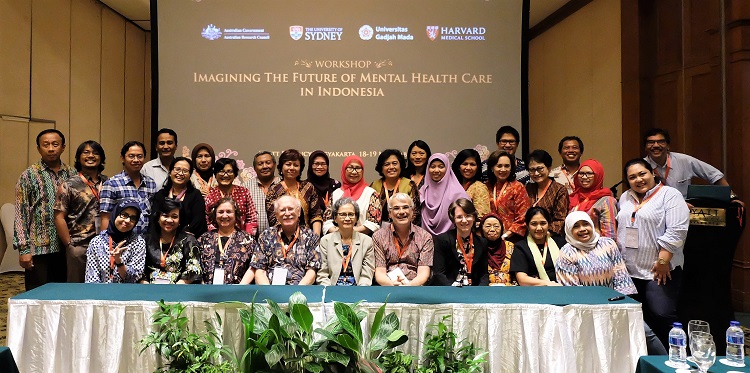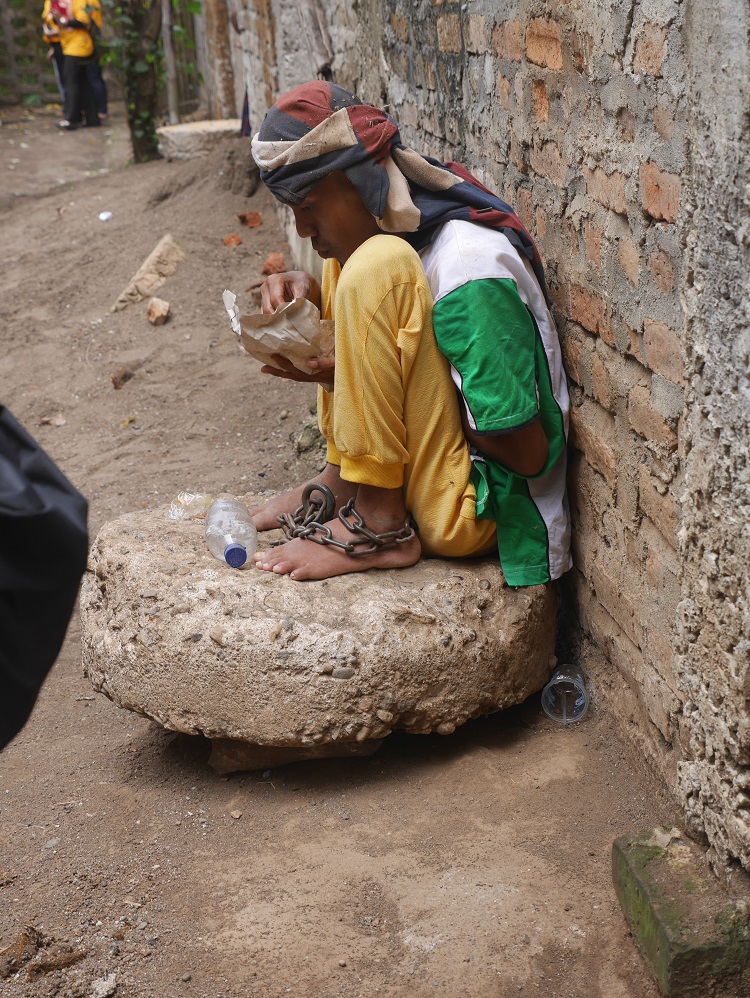Versi Bh. Indonesia
An introduction to the edition
Hans Pols
Indonesia faces tremendous challenges in the field of mental health. There is a severe shortage of mental health personnel as well as treatment and care facilities. The stigma against mental illness and psychosocial disabilities is strong. Fortunately, there are many committed and enthusiastic psychiatrists, psychologists, mental health nurses, social workers, mental health advocates, groups formed by individuals with a lived experience of mental disorder, caregivers, and volunteers dedicated to change. This edition of Inside Indonesia investigates the current state of mental health care in Indonesia, explores ideas on how to realise improvements, and reports several successful and innovative initiatives.
According to the data of the Agency of Health Research and Development of the Indonesian Ministry of Health, there are just over 450,000 families in Indonesia with at least one family with schizophrenia. In just over four million families, at least one family member has depression.
For many individuals with mental disorder, access to mental health care remains very difficult, especially in rural and remote areas.
The Indonesian government currently dedicates approximately 1 per cent of its total health budget to mental health; total health expenditure is around 3 per cent of GDP. The capacity of Indonesia’s 48 mental hospitals and 269 psychiatric wards in general hospitals is much lower than the demand. In the major urban centres, a modest number of psychiatrists and clinical psychologists operate private practices. There are many informal and unofficial institutions, generally faith-based, that accommodate individuals with mental illness. Conditions in these institutions tend to be dire. There are currently initiatives to provide mental health care in community health centres (puskesmas), a development that is very promising but only in its initial stages. Eight provinces do not have a mental hospital and three do not even have a single psychiatrist. There are currently just under 1,000 psychiatrists, 2,000 registered clinical psychologists, and close to 7,000 community mental health nurses, for a population of almost 270 million. If Indonesia had the same number of psychiatrists per capita as Australia, there would be almost 38,000. Indonesia’s Ministry of Health estimates that about 90per cent of individuals with mental disorders or psychosocial disabilities do not receive adequate mental health care.
The condition of individuals with severe mental illness in Indonesia regularly receives international attention. In 2017, Human Rights Watch published a highly critical report entitled Living in Hell: Abuses against People with Psychosocial Disabilities in Indonesia. This report highlights the dismal conditions in social welfare and informal institutions, which are often unhygienic and overcrowded. Inmates are regularly shackled. Medical care is only sporadically provided.
In rural and remote areas, some families shackle individuals with severe mental illness, confine them to small rooms or huts, or lock one or both legs in heavy wooden blocks. This practice is called pasung. Families do this to prevent violence, and damage to their own livestock and property or that of their neighbours. More than 57,000 Indonesians have experienced pasung at least once in their lifetime. In July 2018, the number of individuals thus confined was estimated to be around 12,800 – 6,000 fewer than 2 years before.
Shackling
The first section of this edition discusses pasung and the initiatives undertaken to eradicate it. Photojournalist Andrea Star Reese has, over the last ten years, documented the lives of individuals with psychosocial disabilities, many of whom are in pasung. Diana Setiyawati reports how mental health activists successfully advocated for an alternative institution for several severely mentally ill people who were found shackled in an informal shelter. Ade W. Prastyani, Diana Setiyawati, and Erminia Colucci discuss how Camillian priests on Flores build ‘Safe Houses’ for individuals with severe mental illness, thus providing alternatives for pasung. In the last article of this section, Anke Felicitas Boeckenfoerde reports on her work with several Catholic institutions on Flores.
Improving mental health services
The second section considers initiatives to improve Indonesia’s mental health care system. Irmansyah evaluates the Indonesia Free from Pasung (Indonesia Bebas Pasung) campaign, which is now in its tenth year. He emphasises the importance of Indonesia’s new health insurance system (JKN/BPJS), which makes health care accessible to all citizens. Over the past several years, several policy initiatives mandate that mental health care is available in Indonesia’s primary health care centres (puskesmas), of which there are almost ten thousand. Eunike Sri Tyas Suci describes several training programs for health professionals and health volunteers that are geared towards improving the care for individuals with mental illness. Nova Riyanti Yusuf discusses Indonesia’s mental health law, which she helped formulate and pass in 2014. Byron J. Good, in collaboration with the Yogyakarta mental health team and Mary-Jo DelVecchio Good, discusses a number of initiatives to build a mental health system that focuses on recovery instead of merely providing medication or temporary care in mental hospitals or psychiatric wards. Santi Yuliani recounts how she and her colleagues at the Magelang mental hospital integrate Javanese culture and modern technology in the treatments they provide. In the last article in this part, Hervita Diatri discusses the role of hospital accreditation and the quality of care provided in psychiatric wards in general hospitals.
Specialised initiatives
In the third section articles examine several specialised initiatives. Indonesia is located on the ring of fire; volcanic eruptions, earthquakes, and other natural disasters occur all too frequently. Albert Maramis describes how Indonesian mental health professionals have developed specialised expertise in providing care after natural disasters. Aliza Hunt analyses how Indonesian mental health professionals think about depression, which is a problem that does not receive the attention it requires. Benny Prawira reports how members of Into the Light Indonesia, a group that focuses on suicide prevention among youth, participated in formulating guidelines for suicide reporting in the media. Agus Sugianto discusses two organisations – Indonesian Schizophrenia Care Community and Bipolar Care Indonesia – in addition to his activities as a mental health advocate. The activities of various groups of people with a lived experience of mental illness and their carers have added a significant and dynamic element to Indonesia’s mental health scene over the past ten years. In the last article of this section, Retha Arjadi describes an initiative to provide mental health care over the internet, which might be a promising way of delivering mental health care to rural and remote areas.
Reflections
The fourth and final section features two reflections on the current state and future direction of mental health services in Indonesia. Andrea Adhi, Marsha Habib, and Widi Sari discuss the importance of providing care to vulnerable groups, such as homeless children, religious minorities, and LGBTQ individuals. In the last article, Theresia Citraningtyas reflects on the current state of mental health initiatives in Indonesia and what developments she expects to take place in the near future.
Getting to know the mental health scene in Indonesia
This issue of Inside Indonesia grew out of an ARC-funded research project entitled Imagining Indonesian Psychiatry: Past Present and Future (DP140100517; 2014-2017), which allowed me to work with Byron J. Good and Mary-Jo DelVecchio Good of Harvard University. For four years, we travelled across Indonesia and interviewed psychiatrists, psychologists, mental health nurses, social workers, lived experience experts, volunteers, and mental health advocates. We organised several meetings and workshops to discuss the future of mental health care in Indonesia. We were delighted to meet many committed, dedicated, and enthusiastic people who had undertaken innovative and successful programs in the past and who were full of ideas about what could and should be done in the near future. We put together a two-volume edited book with contributions of more than fifty Indonesian authors: The Future of Mental Health Care in Indonesia (Jiwa Sehat, Negara Kuat: Masa Depan Layanan Kesehatan Jiwa di Indonesia, Kompas, 2019). We are currently preparing an English version.
The challenges in providing adequate mental health care to everybody who needs it are enormous. So is the energy and ingenuity of the people who are dedicated to achieving this goal.

Dedication
This issue of Inside Indonesia is dedicated to two Indonesian mental health pioneers, Dr. Pandu Setiawan and Dr. Laurentius Panggabean. Both are no longer with us.
For many years, Dr. Pandu played a leading role in mental health care in Indonesia. He served as director of several mental hospitals. During the last decade of his life, he stimulated discussions about the organisation of mental health care and tirelessly advocated for the development of a comprehensive health care system where mental health care would be available at primary, secondary, and tertiary levels. He hoped that care and treatment in mental hospitals would be supplemented by care in the community. During the last years of his life, he spearheaded initiatives in psychosocial rehabilitation, and strongly encouraged and supported groups of individuals with mental illness. We miss his presence in Indonesia’s mental health community.
We also dedicate this edition to the late Dr. Laurentius Panggabean, who passed away on 12 March 2020 as President Director of Soeharto Heerdjan Mental Hospital in Jakarta. He was also past President Director of the Drug Addiction Hospital (Rumah Sakit Ketergantungan Obat) Cibubur and Lawang Mental Hospital in East Java. He was truly a mental health hero and he was also one of the first martyrs from COVID-19 in Indonesia. Sadly, his family were not informed of the diagnosis until after the funeral. Hundreds of people had come to pay tribute, and the grieving family were sadly stigmatised and even wrongly accused for endangering others.
Special thanks
Many thanks to Chris Hesselbein for copy-editing all English articles, and to Aliya Supriyadi for translating most articles in this issue, and Nurul Fadhila Praharso, Anindita Gabriella, Ninik Supartini and Ade Prastyani for additional translation work.
Hans Pols (hans.pols@sydney.edu.au) is associated with the School of History and Philosophy of Science at the University of Sydney.
Listen to a podcast with Hans Pols about this special issue, hosted by the Sydney Southeast Asia Centre.
